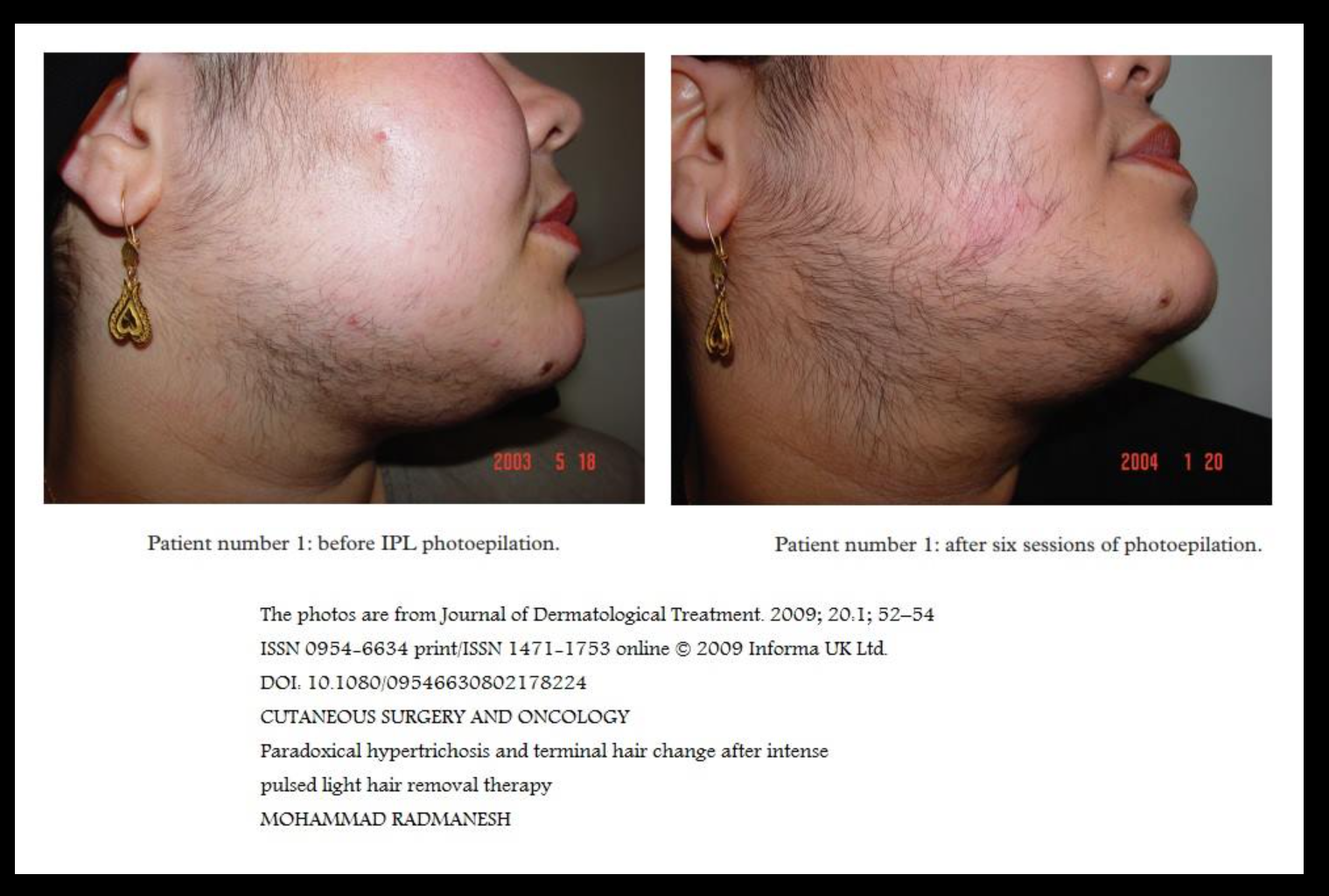Paradoxical Hair Growth

On occasion I have had a handful of clients new to Skindevour advise that they have had laser hair removal before, and their hair has grown back even worse than it was before. Can this happen??? The answer is yes!
A notable and underreported side effect of laser hair removal is called paradoxical hypertrichosis (Honeybrook et al, 2018). It is an uncommon occurrence and poorly understood adverse effect associated with laser or intense pulsed light treatment for hair reduction (Snast et al, 2021). It most commonly occurs and the face and neck in about 4% of the population but has been reported to also occur in other areas, largely the areas being treated for hair reduction however it has also been identified beyond the treated areas as well. (Radmanesh, . M., 2009)
Research and current literature suggest paradoxical hypertrichosis it most commonly to affects people with a darker skin type (Fitzpatrick III–IV) however has also been found to effect individuals with lighter skin types as well.
What happens is one of two things. Either there is an apparent amount of increased terminal hair or vellus hair turns into terminal hair. Vellus hair is the thin, short and usually lighter coloured hair the grows on most areas of the body and particularly the sides of face. (Eksomtramage T. et al, 2018) Terminal hair, on the other hand, is “coarse, thick hair that is found on the scalp, underarms, and pubic area and on the face for males” (Saleh, D. 2022). During puberty vellus hair is replaced with terminal hair.
The exact mechanism of action (how it occurs) for paradoxical hypertrichosis after laser and IPL hair removal therapy is not known. (Radmanesh. M., 2009) and beyond the treated areas.
Whilst the exact cause is not determined, what can be said is that the type of device/modality is not a contributing factor however in Radmanesh. M., (2009) studies, which focused on only IPL devices, he suggested that his findings indicated “IPL therapy may have some structural or biochemical stimulatory effects on hair growth in some individuals.
Änother theory suggests that using suboptimal laser fluences and prolonged treatment intervals may predispose individuals to the development of this unwanted side effect. This theory is not confirmed and hence why different clinics may recommend different internal times between sessions. (Honeybrook et al 2018
However, this theory has never been confirmed, and hence the reason for considerable variation between practitioners when recommending intervals between treatment sessions (Honeybrook et al 2018).
One study confirmed that terminal hair growth in most people occurred when treatment intervals were more than 8 weeks apart and consequently advise that the most appropriate intervals for treatment would be between 4 and 6 weeks (Schroeter et al, 2004).
What happens if I experience increased hair growth during hair reduction treatments?
It’s always a good idea to have some before and after photos so you can show the difference in growth, although we may not always think of doing this when first commencing treatments.
If you feel your hair growth is increasing, I recommend speaking with your treating practitioner about what you are experience and discussing the settings being used on the device. One option may be to continue treatments using the same device but with an increased fluence.
Another option could be to try a completely different device with a different practitioner who may consider all aspects of the device including wavelength. If you’re currently having your treatments using Intense Pulse Light (IPL) you may consider switching to Laser – they are different modalities, and you may have greater success over one than the other.
Studies have shown that the new terminal hairs do transition back to vellus over time, but this could be a significant period of time (Honeybrook et, al, 2018) so in my humble opinion, it probably isn’t worth the wait and the best option is to find a different treatment provider who understands the condition in greater detail and is able to appropriately treat your skin type.
References:
Alajlan, A., Shapiro, J., Rivers, J. K., MacDonald, N., Wiggin, J., & Lui, H. (2005). Paradoxical hypertrichosis after laser epilation. Journal of the American Academy of Dermatology, 53(1), 85–88. https://doi.org/10.1016/j.jaad.2004.06.054
Eksomtramage, T., Aiempanakit K., (2018) Tinea of vellus hair: a diagnostic and therapeutic challenge. BMJ Case Reports bcr2017223678. doi: 10.1136/bcr-2017-223678. PMID: 29437818; PMCID: PMC5836685.
Honeybrook, A., Crossing, T., Bernstein, E., Bloom, J., & Woodward, J. (2018). Long-term outcome of a patient with paradoxical hypertrichosis after laser epilation. Journal of Cosmetic and Laser Therapy : Official Publication of the European Society for Laser Dermatology, 20(3), 179–183. https://doi.org/10.1080/14764172.2017.1383614
Radmanesh, M. (2009). Paradoxical hypertrichosis and terminal hair change after intense pulsed light hair removal therapy. The Journal of Dermatological Treatment, 20(1), 52–54. https://doi.org/10.1080/09546630802178224
Saleh, D., Yarrarapu, S.N.S., Cook, C., (2022) Hypertrichosis. StatPearls Publishing; PMID: 30521275.
Schroeter, C.A., Groenewegen, J.S., Reineke, T., Neumann, H.A., (2004) Hair reduction using intense pulsed light source. Dermatol Surg, 30(2 Pt 1,) 168-73. doi: 10.1111/j.1524-4725.2004.30054.x. PMID: 14756645.
Snast, I., Kaftory, R., Lapidoth, M., & Levi, A. (2021). Paradoxical Hypertrichosis Associated with Laser and Light Therapy for Hair Removal: A Systematic Review and Meta-analysis. American Journal of Clinical Dermatology, 22(5), 615–624. https://doi.org/10.1007/s40257-021-00611-w
